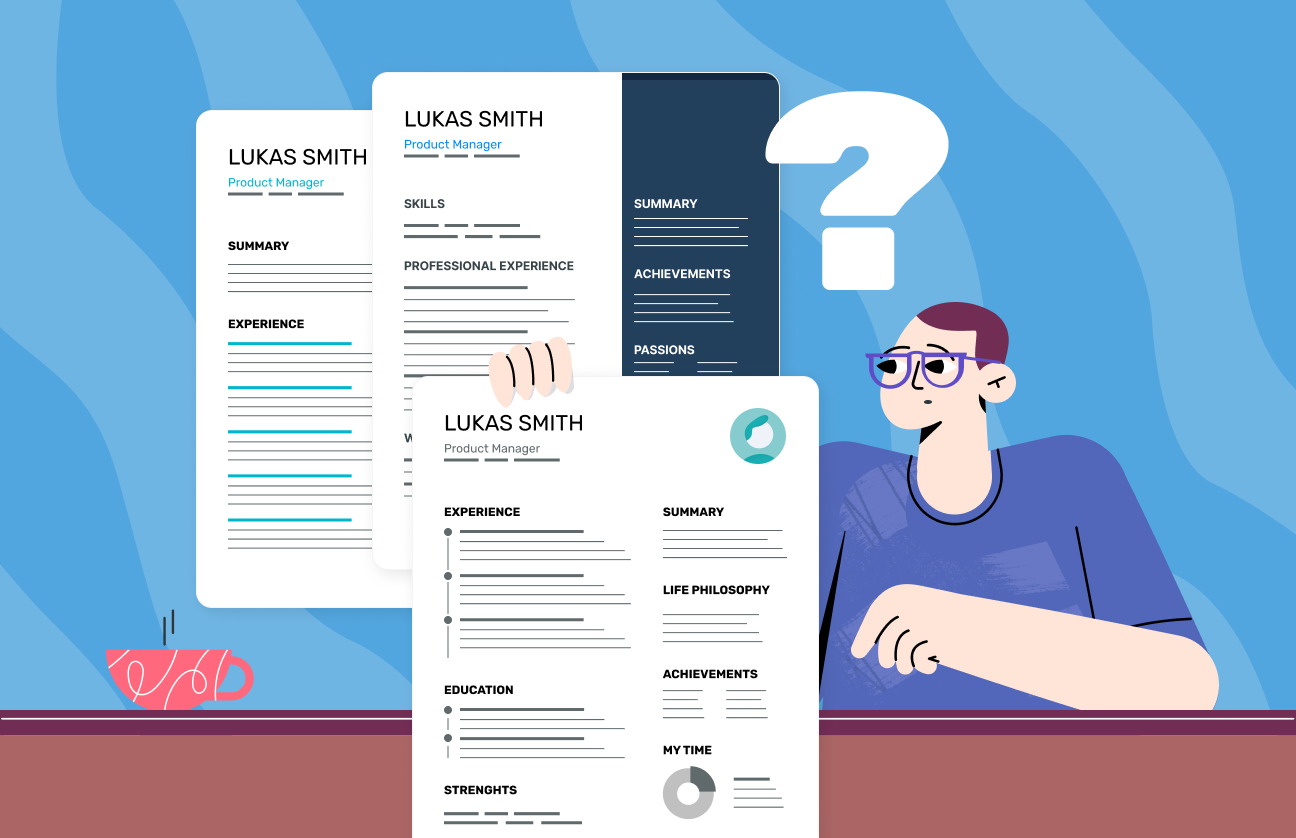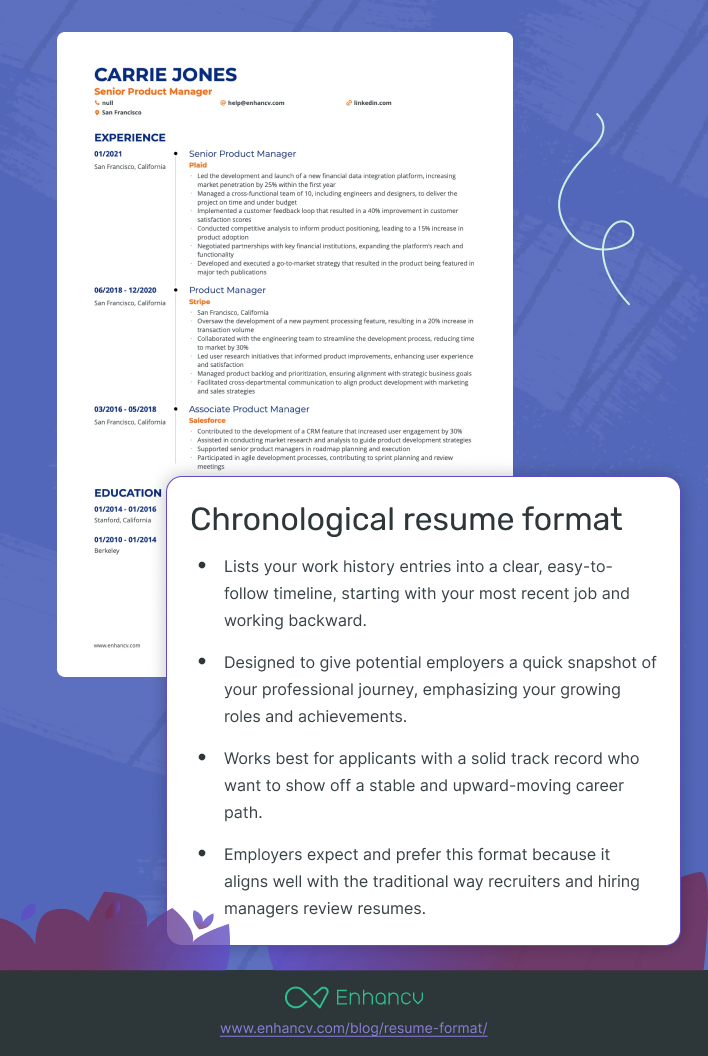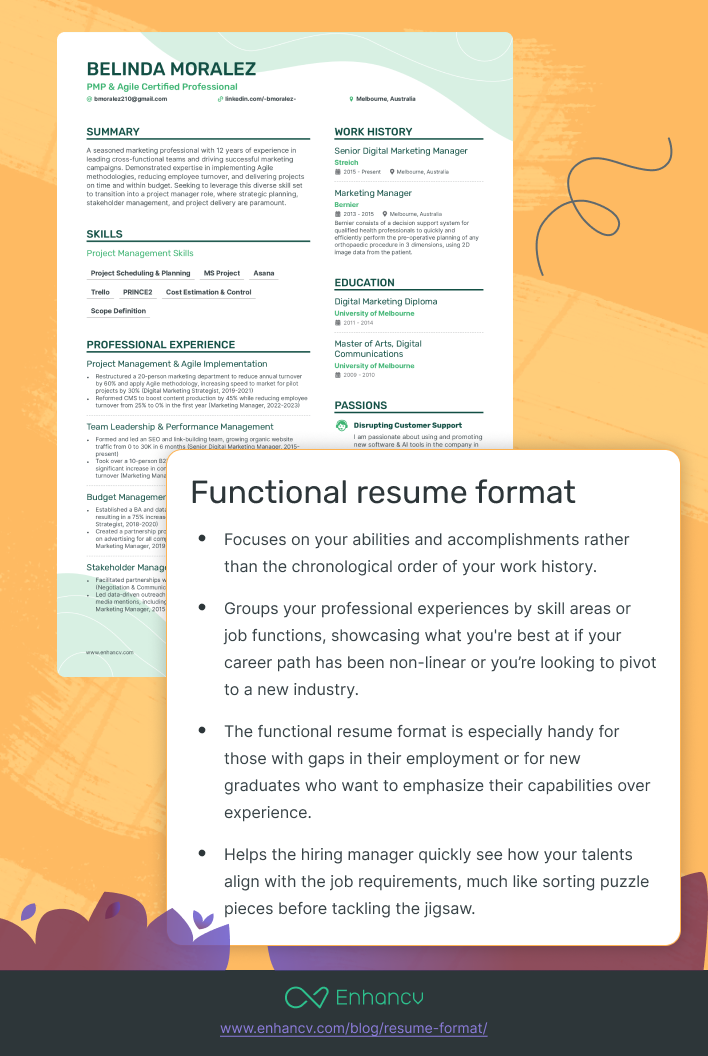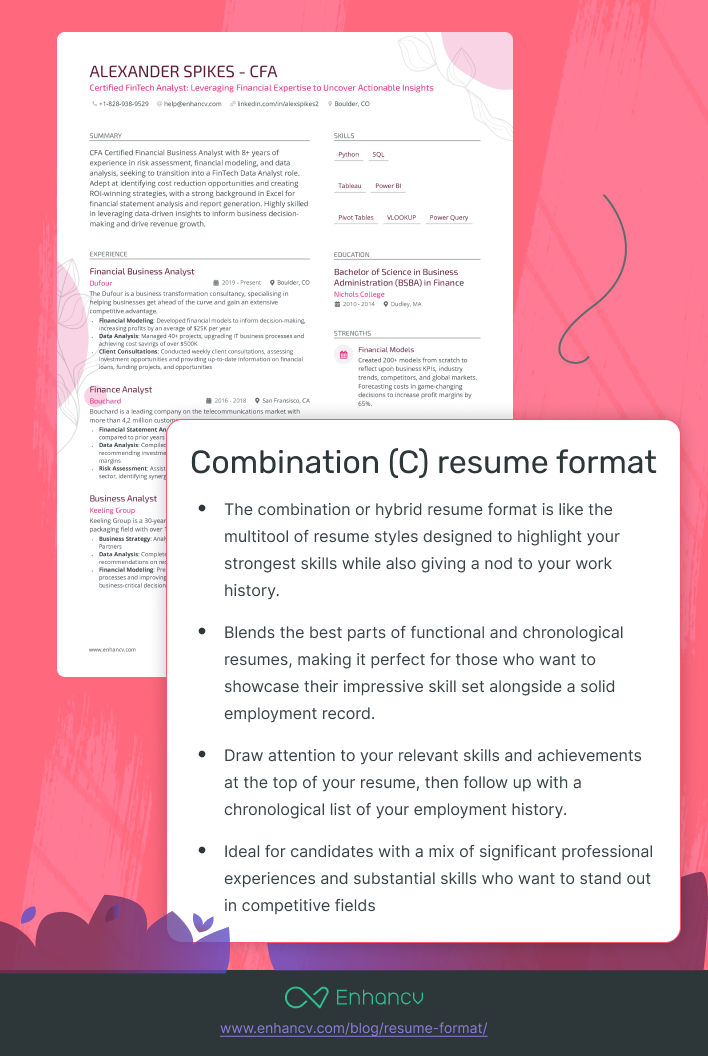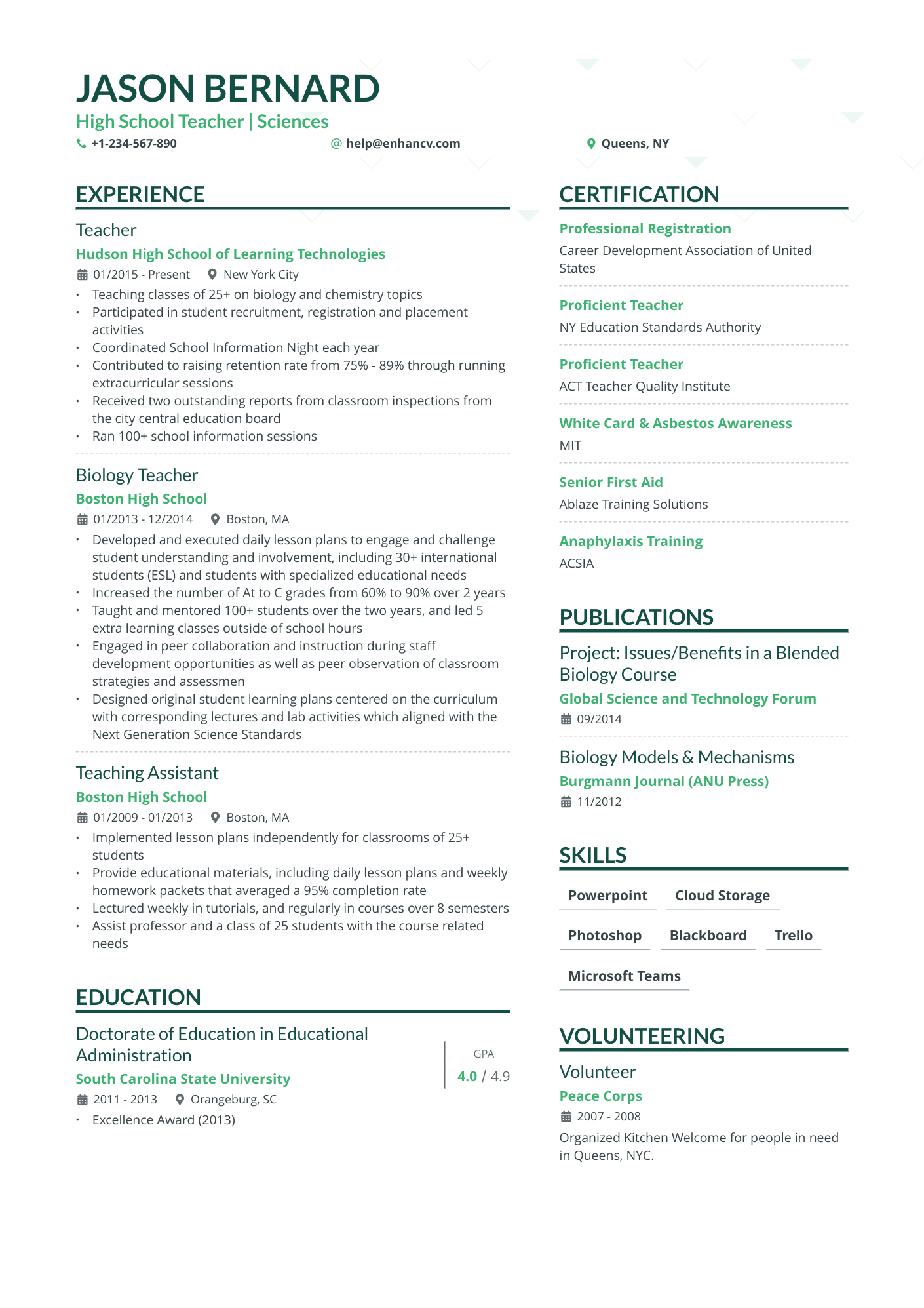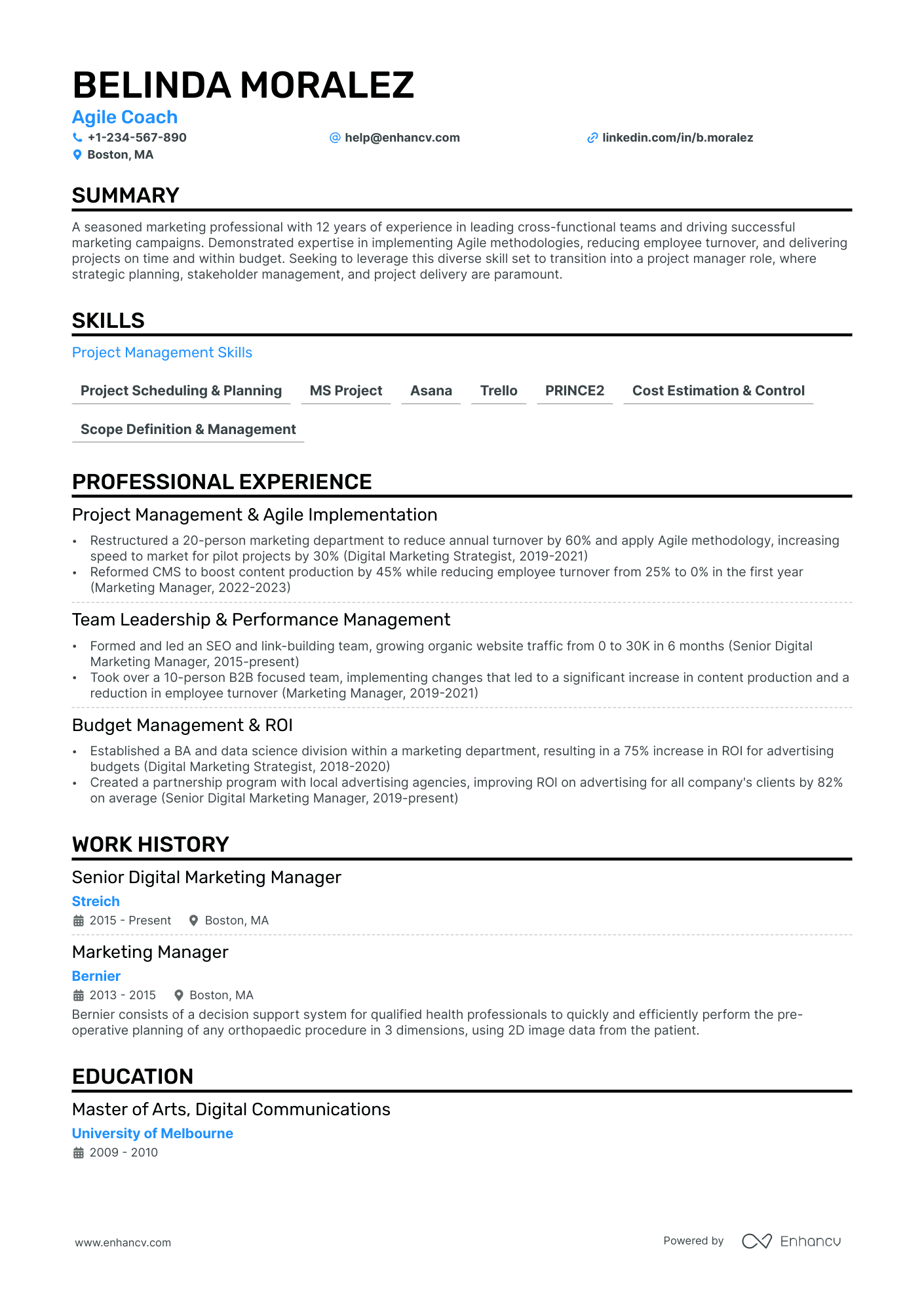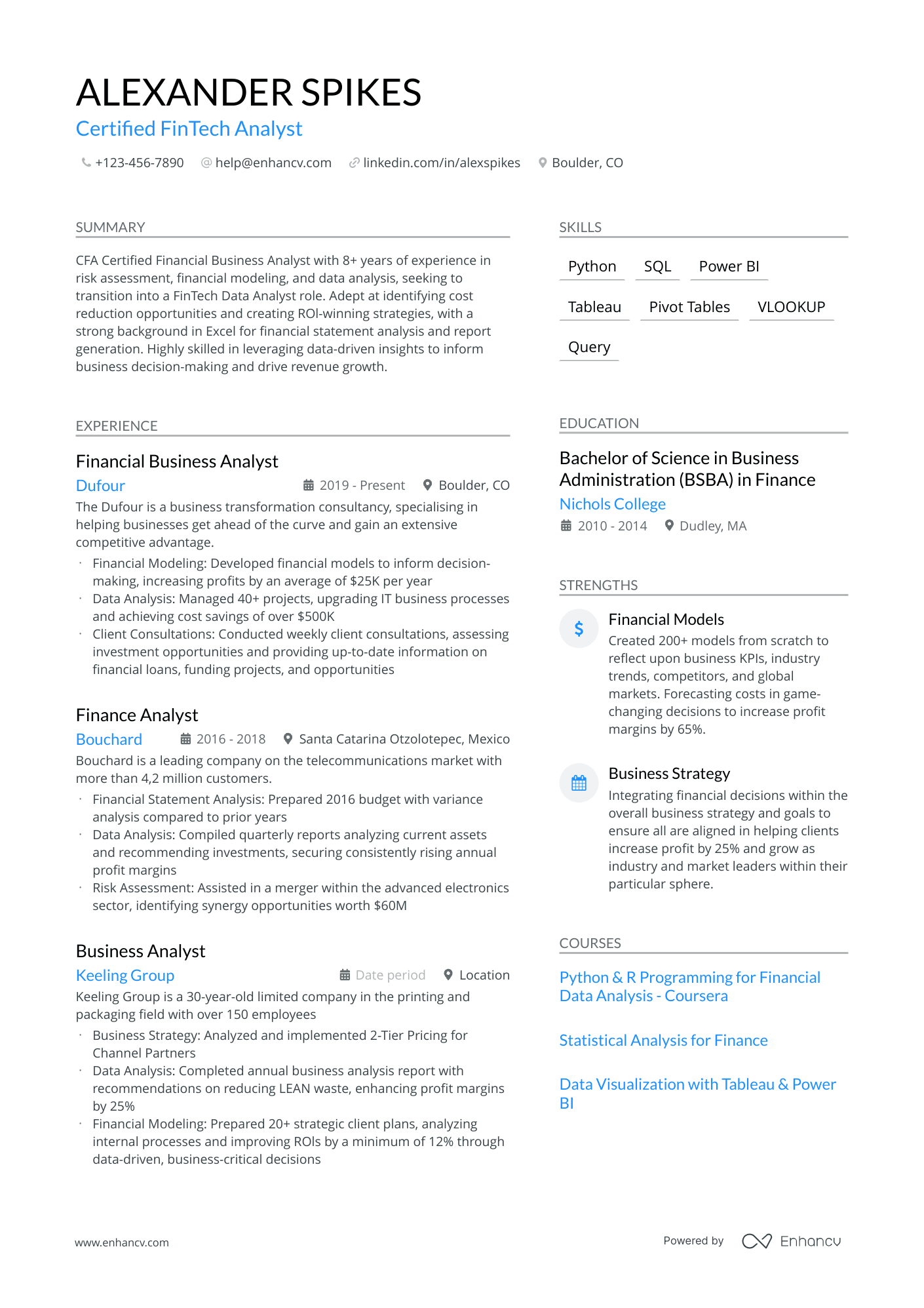Think of your resume as the blueprint of your career—whether you're constructing a skyscraper or a cozy cottage, the foundation needs to be rock-solid.
Navigating the world of resume formats can be a bit like finding the perfect fit in a wardrobe of workwear. From the timeless classic of the reverse chronological resume to the skill-forward functional format, and the best-of-both-worlds combination style, each has its own flair.
Did you know that over 90% of hiring professionals are familiar with the reverse chronological format? So, let’s 'format' your career aspirations and tailor your resume to suit your professional storyline!
The resume format you choose should reflect your personality and speak to the specific job to which you're applying.
Richard Nelson Bolles
So, you may be wondering what these formats are and what they each entail exactly—let’s go ahead and get into them.
The three most popular resume formats
Depending on your work history and career goals, different formats can help showcase your strengths. Selecting the ideal format ensures that hiring managers see you in your best light, making it easier for them to spot your talents and fit for the role. It's a key step in getting your foot in the door!
They each contain unique elements which we explore below.
Reverse chronological
- The reverse chronological resume format is like a timeline that showcases your professional journey from the most recent to the earliest. It lists your work experiences with the latest job at the top, followed by earlier ones, so hiring managers can quickly see where you’ve been and how you've progressed.
- This format is especially great for those with a strong work history and clear career progression. It's perfect if you’ve climbed the ladder in a specific field or industry and want to highlight your upward trajectory. It’s less ideal for those with gaps in their employment or who are shifting careers, as it can spotlight these changes more prominently. If stability and growth in your career are your strengths, this format can effectively showcase your professional story!
Functional
- The functional resume format is like your career’s highlight reel, focusing on your skills and experiences rather than the timeline of your work history. It's organized around your abilities and strengths, categorizing your accomplishments under skill headings like "Project Management" or "Communication Skills."
- This format is particularly great for those who are looking to shift industries, have gaps in their employment, or are new to the workforce, such as recent graduates. By spotlighting what you can do and the expertise you bring to the table, the functional resume helps you make a strong case to potential employers, especially when traditional career paths don’t tell your whole story.
Combination or hybrid
- The hybrid or combination resume format is like a Swiss Army knife for job seekers—it's versatile and multifunctional, blending the best elements of chronological and functional resumes. This format allows you to showcase both your impressive career timeline and the diverse skills you've acquired along the way.
- The combination resume is particularly effective for those with a colorful career path, such as individuals changing industries, those with gaps in their employment, or highly skilled professionals with diverse experiences. It lets you tailor your resume to emphasize more relevant skills and experiences, making a compelling case to potential employers about why you're the perfect fit for the job.
Now let’s dive in deeper and dissect each format for you to be able to choose the right one and properly replicate it.
Reverse chronological resume format
The reverse chronological resume format is a favorite for many because it lays out your work history entries into a clear, easy-to-follow timeline, starting with your most recent job and working backward. This setup is perfect for highlighting your career progression, showcasing where you’ve been and how you’ve climbed the ladder over the years.
It’s designed to give potential employers a quick snapshot of your professional journey, emphasizing your growing roles and achievements. This format works best for those with a solid track record who want to show off their stable and upward-moving career path. It’s a straightforward approach that tells your story at a glance.
Writing tips for the reverse chronological resume format
Here are some ways to jazz up your resume writing. Follow these tips to craft a stellar reverse chronological resume:
- Highlight your recent roles: Start with your most recent job and work backward. This format puts the spotlight on your latest accomplishments, showing where you’re now and how you've progressed. It's like telling your career story with the last chapter first!
- Use clear dates and titles: Make sure each job listing includes the start and end dates, job title, and employer. This clarity helps hiring managers see the timeline of your experience at a glance.
- Showcase your achievements: Under each job, highlight your key responsibilities and successes. Use action verbs and concrete numbers to demonstrate your impact. Think of it as giving your career highlights a front-row seat.
- Tailor your content: Target your resume to each individual job application. This shows you’re not just throwing your hat in the ring but are genuinely interested in the role.
- Keep it concise: Even if you have a long work history, focus on the most relevant and recent experiences. You want your resume to be a quick read, not a deep dive.
- Include education and certifications at the end: Place your educational background and any related certifications after your professional experience. This layout supports your practical experience with your academic credentials, ensuring your resume is well-rounded.
- Proofread for perfection: Before sending out your resume, double-check for any typos or grammatical errors. A clean, error-free resume reflects your attention to detail.
Using these tips, you can create a reverse chronological resume that effectively showcases your experience and catches the eye of recruiters, ensuring you look like the top candidate you are!
Pros and cons of the reverse chronological resume format
The reverse chronological resume format is one of the most traditional and widely used styles. It has distinct advantages and some limitations depending on your career history and goals.
Here are the main pros and cons:
Pros
- Clear career progression: This format showcases a clear timeline of your employment history, emphasizing how you have advanced over the years. It's easy for hiring managers to see your growth in a specific field or industry at a glance.
- Familiarity and acceptance: Most employers expect and prefer this format because it’s straightforward and familiar. It aligns well with the traditional way recruiters and hiring managers review resumes.
- Immediate impact: By listing your most recent role first, you immediately highlight your current capabilities and responsibilities, which are often the most relevant to the jobs you’re applying for.
- Highlights stability: It’s excellent for demonstrating continuous employment and upward career mobility, which can be reassuring to potential employers looking for reliable candidates.
Cons
- Highlight gaps in employment: Any gaps in employment are immediately apparent, which can be a drawback if you've had periods of unemployment that might require explanation.
- Less flexible: If you're looking to make a career change or if your most recent experience isn't the most relevant to the jobs you're applying for, this format can work against you by not highlighting the most pertinent skills or experiences upfront.
- Repetitive for similar roles: If you've held very similar roles across different companies, the reverse chronological resume can seem repetitive and make it hard to distinguish between different positions.
- Potential for redundancy: For those with a long career history, this format can lead to a lengthy resume as it requires detailing each role. This could dilute the impact of your most relevant experiences.
Selecting the perfect resume format really hinges on your unique career journey, the specific job market, and how you want to showcase your experience to potential employers. The reverse chronological format is a solid and popular choice for many, but it's always smart to think about how it aligns with your personal job search goals. It’s all about finding the best fit for you!
Functional resume format
The functional resume format is like a highlight reel for your skills—it focuses on your abilities and accomplishments rather than the chronological order of your work history. Think of it as putting your best foot forward in a talent show, where your skills take center stage instead of the timeline of your previous roles.
This format groups your professional experiences by skill areas or job functions, allowing you to showcase what you're best at, particularly if your career path has been non-linear or you’re looking to pivot to a new industry. It's especially handy for those with gaps in their employment or for new graduates who want to emphasize their capabilities over experience.
The main focus of the functional resume is to play up your strengths and potential, ensuring that recruiters see your best bits first, much like arranging the tastiest dishes at the front of a buffet.
Writing tips for the functional resume format
Here are some writing tips for crafting a functional resume that not only showcases your skills but also makes your application stand out.
- Lead with a strong summary: Start with a punchy professional summary that outlines your key skills and how they translate to success in the role you're applying for. Think of it as your opening act—make it memorable!
- Organize by skill categories: Group your skills into relevant categories (e.g., Customer Service, Project Management, Technical Proficiency). This helps the hiring manager quickly see how your talents align with the job requirements, much like sorting puzzle pieces before tackling the jigsaw.
- Highlight achievements with metrics: For each skill category, include specific achievements and quantify them where possible (e.g., "Improved customer satisfaction by 20% through personalized service strategies").
- Include a relevant experience section: List job titles, companies, and dates in a brief section at the end of the resume. This provides context for your skills without focusing on the chronological order of your work history.
- Tailor your skills to the job description: Make sure the skills and achievements you highlight are directly related to the job you're applying for. This shows you're not just throwing everything at the wall to see what sticks, but carefully crafting your pitch.
- Use powerful action verbs: Start bullet points with dynamic action verbs that convey action and achievement (e.g., executed, designed, transformed). These verbs help paint a vivid picture of your capabilities.
- Keep it concise and focused: Avoid the temptation to include every skill you possess. Focus on the ones most relevant to the job, ensuring each word on your resume works as hard as you do.
- Proofread for clarity and impact: Make sure your resume is clear, concise, and free of errors. This is your professional portrait; polish it until it shines.
By following these tips, your functional resume will effectively showcase your skills in a way that's tailored and appealing, designed to fit just right for the job at hand.
Choosing a resume format is like choosing an outfit for your cat. It might not like any of them, but you have to pick one that makes it look purr-fessional.
Pros and cons of the functional resume format
The functional resume format, also known as a skills-based resume, can be particularly useful in certain situations, but it also has some potential drawbacks.
Here are the major pros and cons:
Pros
- Highlights skills over employment gaps: If you have gaps in your employment history or are changing careers, the functional format allows you to focus on the skills and experiences relevant to the job you’re applying for, rather than when or where you worked.
- Tailors to the position: This format makes it easier to tailor your resume to specific job postings by emphasizing the skills and accomplishments that align closely with the job requirements.
- Showcases transferable skills: Ideal for those who have a diverse skill set from various fields or industries, the functional resume can effectively highlight abilities that are applicable across different jobs.
Cons
- Less familiar to recruiters: Many hiring managers are more accustomed to the chronological resume format and might find the functional style confusing or suspect it's being used to hide something, such as employment gaps or a lack of relevant job titles.
- Can lack context: By not tying skills directly to specific jobs and dates, it can be harder for employers to see how and where you developed your skills. This lack of context can make your accomplishments seem less tangible.
- May not pass applicant tracking systems (ATS): Many companies use ATS to scan resumes for related keywords and chronological data. Functional resumes can sometimes be difficult for these systems to interpret, which might prevent your resume from being passed along to a human reviewer.
Choosing the right resume format is critical, and the functional resume can be a powerful tool in the right circumstances, especially when it's used to strategically present a candidate's skills in the best possible light.
Combination resume format
The combination or hybrid resume format is like the multitool of resume styles—it's specially designed to highlight your strongest skills while also giving a nod to your work history. This format blends the best parts of functional and chronological resumes, making it perfect for those who want to showcase their impressive skill set alongside a solid employment record.
The main focus of the combination format is to first draw attention to your relevant skills and achievements at the top of your resume, then follow up with a chronological list of your employment history. This approach is fantastic for people making a career change, as it allows them to highlight the skills that are transferable to new fields.
It’s also ideal for candidates with a mix of significant professional experiences and substantial skills who want to stand out in competitive fields. The combination resume offers a flexible platform to impress potential employers by showing them exactly what you can bring to the table.
Enhancv gives you all the personalization you might need and loads of templates to get you started with your resume. If, however you want to open it up in a document editor, you can still do that.
Writing tips for the combination resume format
Here are some friendly and informative tips to help you craft an effective combination resume that's sure to catch an employer's eye:
- Lead with your strengths: Start with a 'Resume Summary' or 'Professional Profile' section that highlights your top skills and achievements. Think of it as your career highlight reel, showcasing your MVP moments right off the bat.
- Detail relevant skills: Before you dive into your work history, create a 'Skills' section where you can detail your transferable skills and abilities relevant to the job you’re applying for. This is your chance to shine a spotlight on your expertise.
- Include a reverse chronological work history: Follow up your skills with a concise work history, listed in reverse chronological order. This part shouldn’t just list where you worked, but also emphasize how you put those top-billed skills to use in each role.
- Quantify your achievements: Wherever possible, use numbers to measure your success. Whether it’s increasing patient satisfaction by 20% or reducing office supply costs by 30%, numbers provide a clear picture of your impact.
- Tailor each resume: Customize your resume for the specific job you're applying for by emphasizing the skills and experiences that align most closely with the job description. It’s like choosing the right tool for the right job—precision is key.
- Keep it streamlined: Even though you're blending skills and experiences, keep your resume concise. Avoid the temptation to overload it with information. Remember, it’s a teaser, not a tell-all.
- Proofread for perfection: Double-check your resume for typos and grammatical errors.
Using these tips, your combination resume will not only highlight your capabilities but also provide a clear, comprehensive view of your professional journey, making you an irresistible candidate for any job opening.
Pros and cons of the combination resume format
The combination or hybrid resume format blends the best features of chronological and functional resumes, making it a versatile choice. However, like any format, it has its advantages and drawbacks depending on the context and the candidate's background.
Here are the biggest pros and cons:
Pros
- Versatility: The combination resume highlights relevant skills upfront while also providing a clear timeline of work history. This makes it ideal for candidates with a strong set of skills and a solid employment record.
- Appeals to career changers: It allows individuals transitioning between fields or industries to showcase the skills that are applicable to their new career path, while still detailing their work history.
- Focus on strengths: By emphasizing skills and accomplishments that are most relevant to the job, helps the candidate to make a strong case for their candidacy, even if they have gaps in their employment or are re-entering the job market.
Cons
- Complexity: This format can be more complex and harder to write because it requires a careful balance between showcasing skills and presenting a chronological work history.
- Length issues: Combination resumes can become lengthy as they include a lot of detailed information. This can potentially dilute the impact of the key messages you want to convey if not well-organized.
- Potential for redundancy: There’s a risk of repeating information between the skills and experience sections, which requires meticulous editing to ensure clarity and conciseness.
- Recruiter skepticism: Some recruiters prefer the traditional chronological format and might view combination resumes with skepticism, particularly if they feel the format is being used to hide employment gaps or a lack of relevant experience.
Overall, the combination resume can be a powerful tool for many job seekers, but it needs to be carefully crafted to ensure it effectively communicates the candidate's strengths without overwhelming the reader with too much information.
Comparison between the chronological, combination, and functional resume formats
When choosing between the three primary resume formats—reverse-chronological, functional, and combination—it's essential to consider how each format presents key elements like summary, skills, work history, and education.
Here’s a cohesive comparison to help you decide which might be best for your needs:
Reverse-chronological resume
- Summary: Typically includes a brief statement that highlights career achievements and major professional qualities.
- Work history: The centerpiece of this format, it lists all jobs in reverse order, starting with the most recent. Each entry focuses on the role and accomplishments, demonstrating career progression.
- Skills: Generally integrated into the work history section or briefly listed; this format assumes that skills are evident from job descriptions.
- Education: Listed after work history, focusing on degrees earned and institutions attended, often including graduation dates.
Combination resume
- Summary: Similar to the reverse-chronological, this also includes a powerful introduction but may lean more towards outlining specific skill sets that are particularly relevant to the job applied for.
- Key skills or summary of qualifications: Prominently features a detailed listing of skills and qualifications at the top of the resume to immediately showcase capabilities.
- Work history: Still important but secondary to skills, it’s usually concise, showing only the job title, company, and duration, with less emphasis on job duties.
- Education: Presented similarly to the reverse-chronological format, often placed at the end of the resume.
Functional resume
- Summary or objective statement: This may include a clear career objective or a brief summary that aligns more closely with the candidate’s career goals.
- Summary of qualifications: Highlights professional accomplishments and abilities at the top, making it easy for employers to see the candidate’s value right away.
- Skills sections: The core of this format, multiple skills sections are tailored to reflect the job seeker’s strengths as they relate to the job they’re applying for.
- Work history: This section is downplayed, often listed simply as job titles, names of employers, and dates of employment, with minimal detail on the responsibilities or achievements in each role.
- Education: Typically listed at the end; similar to other formats but may include additional relevant training or coursework to compensate for less detailed work history.
Overall comparison
- Reverse-chronological: Best for those with a strong and steady employment record who want to highlight career progression.
- Functional: Ideal for those with gaps in employment, those changing careers, or where specific skills are more important than chronological work experience.
- Combination: Great for candidates with strong skills and some professional experience who want to highlight both without prioritizing one over the other.
Each format serves different purposes and suits different career needs, making it crucial to choose the one that best represents your professional experiences and highlights your qualifications most effectively.
Resume formatting tips
To land your dream job, it's crucial to not just list your experiences and skills, but to present them in a way that captures attention and communicates clearly; the following resume formatting tips are designed to help you do just that, ensuring your resume makes a memorable first impression.
Here at Enhancv, we’re happy to be able to provide you with our unequaled resume builder that assists you in every way possible on your formatting journey. Our builder does all the heavy lifting so that your resume is formatted in the most professional and effective way.
Have a try and upload your current resume to see some immediate ways it can be improved and to get a glimpse at some of our formatting capabilities.
Is your resume good enough?
Drop your resume here or choose a file. PDF & DOCX only. Max 2MB file size.
Choose the right font style and font size
When crafting your resume, choosing the right resume font size and style is just as critical as the content itself. The goal is to ensure readability and professionalism, helping your resume stand out in the best way possible. While Arial and Times New Roman are traditional choices, branching out into other fonts like Rubik, Volkhov, Lato, and Montserrat can give your resume a fresh, modern feel. These fonts are not only professional but also designed for clarity and easy reading on both screens and print.
For most resumes, the best font size for the body of the text is typically between 10 and 12 points. This range makes your resume accessible and readable without straining the eyes of HR professionals. Titles and headers can be slightly larger, around 14 to 16 points, to create a visual hierarchy that guides the reader through your document effectively. It’s important to maintain consistency in your font choices throughout the document to keep the look unified and professional.
If you're looking for an easy way to apply these tips and ensure your resume looks its best, the Enhancv Resume Builder is a fantastic tool. This platform not only offers a variety of fonts beyond the standard options but also helps you determine the optimal font size and layout for readability and impact. With the Enhancv Resume Builder, you can streamline the formatting process, making sure your resume is both appealing and professional with just a few clicks.
Set the proper margins and spacing
When formatting your resume, it’s crucial to set proper margins and spacing for a professional look. Aim for 1-inch margins all around and use 1.0 to 1.15 line spacing within sections for readability, ensuring your text isn't too cramped.
Between different sections, increase spacing to 10-12 points to clearly differentiate each part. This spacing strategy helps maintain a clean, uncluttered appearance, making your resume easy to scan and visually appealing.
Format your work experience bullets properly
When formatting your work experience on your resume, it's all about clarity and impact. Here's how to make sure your bullet points hit the mark:
- Start with strong action verbs: Begin each bullet point with a dynamic action verb to capture attention and convey your accomplishments.
- Highlight achievements with quantifiable results: Whenever possible, use numbers to detail your successes. This quantification makes your accomplishments more tangible and impressive.
- Order your bullet points strategically: Arrange your bullet points in order of relevance and impact. Start with the achievements that are most impressive and most relevant to the job you're applying for. This might mean not always going in chronological order within each job listing.
- Keep it relevant and concise: While you might want to share everything you've done, focus on the experiences that directly align with the job you're seeking. Each bullet should offer value and paint a picture of your capabilities. Aim for 4-6 bullets per job to avoid overwhelming the reader.
- Consistency is key: Make sure each bullet point is formatted the same way. This means consistent punctuation, capitalization, and structure.
Save your resume in the appropriate format
Unlike a Word document (.docx), which can look different on various computers depending on the software version and settings, a PDF file locks in your layout, fonts, and styling. This ensures that what you see is what the hiring manager gets. It’s a reliable, professional choice that prevents the contents from spilling over or shifting around unexpectedly. This makes PDFs the go-to format for sending resumes, guaranteeing your first impression is exactly as you designed it.
Resume format template
Below we’ll go over each format type and provide comprehensive templates for you to be able to easily work with.
Chronological resume template
Ready to put your career journey front and center? Our reverse chronological resume template is designed to showcase your professional progression clearly and impressively. You’ve already learned about the strengths of this popular format, so now it’s time to put that knowledge into action.
Best of all, you can create your ideal resume with Enhancv! Get started today and build a resume that stands out in a stack and helps you step forward in your career.
Functional resume template
Ready to give your resume a fresh, modern twist? Our functional resume format template is perfect for showcasing your skills and qualifications in a style that's also popular in Canada.
While many online templates lean towards a functional design, Enhancv’s modern resume templates stand out because they're versatile—you can tailor them to any resume format to suit your needs.
Dive in and start personalizing your resume to highlight your unique capabilities and make a strong impression!
Combination resume templates
Ready to put your best foot forward? Our hybrid or combination resume template is designed just for you. Tailored to blend your standout skills with your impressive experiences, this template is especially preferred by students who want to showcase their academic and extracurricular achievements alongside their work history.
Dive in and start customizing it to highlight your unique journey and catch the eye of your dream employer!
Key takeaways
As we wrap up our discussion on resume formats, here are the ten most important takeaways to remember:
- Flexibility of formats: Each resume format (chronological, functional, combination) serves different purposes, catering to various career needs and backgrounds.
- Strengths of the combination resume: It highlights relevant skills upfront while providing a clear work history, making it ideal for those with strong skills and solid employment records.
- Challenges with the combination format: It can be complex to write and may lead to lengthy or redundant content.
- Reverse-chronological format: Focused on career progression, it lists jobs in reverse order and is best for those with a steady work record.
- Functional resume: Emphasizes skills over work history, ideal for career changers or those with gaps in employment.
- Tailoring your resume: Customize your resume for each job application to highlight the most relevant skills and experiences.
- Importance of proofreading: Always double-check your resume for errors to maintain professionalism.
- Choosing the right font and size: Use professional fonts like Rubik, Volkov, Lato, and Montserrat at readable sizes (10-12 for body text).
- Setting margins and spacing: Aim for 1-inch margins and appropriate spacing between sections to enhance readability.
- Effective bullet points: Use strong action verbs and quantifiable results to make your work experience stand out.
Do you still have questions about resume formats?
Here are some of the more frequent questions we get regarding resume formats.
What’s the best format for a resume in 2026?
In 2024, the best resume format is typically the reverse chronological format, as it clearly presents your work history and career progression, making it easy for employers to quickly understand your experience and achievements. This format remains highly favored by recruiters for its clarity and straightforwardness.
Is there a correct format to use for a resume?
There isn't a single "correct" format for a resume; the best choice depends on your career history and goals. Reverse chronological is popular for clear career progression, functional highlights specific skills, and combination resumes blend both approaches for a comprehensive showcase. Choose based on your personal situation.
What resume format do employers prefer?
Most employers prefer the reverse chronological resume format because it clearly presents the candidate’s work history in a straightforward timeline, emphasizing career progression. This format makes it easy for employers to quickly assess a candidate's experience and achievements relevant to the position.
What is a hybrid resume?
A hybrid resume, or combination resume, merges elements of both chronological and functional formats. It highlights relevant skills at the top followed by a reverse chronological work history, making it ideal for showcasing both your abilities and your professional timeline effectively.
Do you have free resume templates?
Yes, we do! Take a minute and have a look at our rich variety of free resume templates.
What’s the best resume format for students?
For students, the combination or hybrid resume format is often the best choice. It allows them to highlight relevant skills and educational achievements up front, while also providing space to detail any work or internship experiences in reverse chronological order. This format helps compensate for less extensive work histories while showcasing their potential and capabilities effectively.
Check out these resume examples directed at different types of students:
- Undergraduate Resume Examples & Guide
- High School Student Resume Examples & Guide
- College Resume Examples & Guide
Can you combine a resume and a CV?
For non-academic research roles or administrative positions at educational institutions, you can. It should include extensive content like research and publications but be more concise than a CV, emphasizing measurable achievements.
This tailored document should span 1.5-2 pages, clearly demonstrating how your academic achievements, experiences, and skills align with the specific job requirements. It's designed for employers who highly value academic backgrounds.
What are the disadvantages of a combination resume?
Keep in mind that while the hybrid resume format offers a detailed look at your employment history, it does mean that frequent job changes, gaps in employment, or unrelated experiences might stand out more than they would in a functional resume.
Which format is best for applicant tracking systems?
When considering resume formats in relation to applicant tracking systems (ATS), it's important to note that the format itself isn't as critical as how the content is structured and presented. ATS systems scan for keywords and phrases that match the job description, so regardless of whether you use a chronological, functional, or hybrid format, what truly matters is how you highlight your relevant skills and experiences.
The key is to tailor your resume to include the skills, experiences, and language found in the job posting. By focusing on aligning your resume with the specifics of the job description and using a clear, straightforward format, you ensure that ATS can parse and rank your application effectively, boosting your chances of getting noticed.
Make one that's truly you.

